Mathematical Assessment of Convection and Diffusion Analysis for A Non-Circular Duct Flow with Viscous Dissipation: Application of Physiology
Abstract
:1. Introduction
2. Mathematical Modeling
3. Exact Solution
4. Validation
5. Results and Discussion
6. Conclusions
- In an elliptic duct, the velocity profile graph shows that the nature of flow is axially symmetric.
- As the value of flow rate Q increases, the behavior of velocity and temperature graphs also goes higher.
- Several interesting research problems can be considered for future work by applying complex non-Newtonian models to the present problem.
- Viscous effects are the core reason behind high convection rates. The rise in temperature is primarily happening due to viscous dissipation.
- The pressure rise graphs disclose the three core sections of multiple pumping regions: free pumping, augmented pumping and co-pumping. There are increasing values in co-pumping but declining values in the augmented pumping section.
- Positive velocity and temperature profiles are observed but a negative concentration profile has also been observed.
- The value of Q is directly proportional to the trapping of streamlines e.g., the size of the trapping of streamlines increases as the value of flow rate increases.
Author Contributions
Funding
Institutional Review Board Statement
Informed Consent Statement
Data Availability Statement
Acknowledgments
Conflicts of Interest
Nomenclature
| Cartesian coordinates | Dh | hydraulic diameter of duct | |
| velocity field | e | eccentricity of ellipse | |
| ao,bo | ellipse half axes | b | bulk temperature (dimensional form) |
| amplitude of wave | occlusion | ||
| wavelength | aspect ratio | ||
| w | tube wall temperature | Br | Brinkman number |
| µ | fluid’s viscosity | Schmidt number | |
| rate of shear | Soret number | ||
| thermal diffusion ratio | coefficient of mass diffusivity | ||
| wall concentration | ) | wave velocity | |
| thermal conductivity | specific heat | ||
| relaxation to retardation times ratio | the retardation time | ||
| extra stress tensor | dimensionless concentration | ||
| density | time (dimensionless) | ||
| pressure | volumetric flow rate | ||
| dimensionless bulk temperature | dimensional time |
References
- Jaffrin, M.Y.; Shapiro, A.H. Peristaltic pumping. Annu. Rev. Fluid Mech. 1971, 3, 13–37. [Google Scholar] [CrossRef]
- Ellahi, R.; Wang, X.; Hameed, M. Effects of heat transfer and nonlinear slip on the steady flow of Couette fluid by means of Chebyshev spectral method. Z. Für Nat. A 2014, 69, 1–8. [Google Scholar] [CrossRef]
- Mansutti, D.; Pontrelli, G.; Rajagopal, K.R. Non-similar flow of a non-Newtonian fluid past a wedge. Int. J. Eng. Sci. 1993, 31, 637–647. [Google Scholar] [CrossRef]
- Bhatti, M.M.; Ellahi, R.; Zeeshan, A. Study of variable magnetic field on the peristaltic flow of Jeffrey fluid in a non-uniform rectangular duct having compliant walls. J. Mol. Liq. 2016, 222, 101–108. [Google Scholar] [CrossRef]
- Böhme, G.; Friedrich, R. Peristaltic flow of viscoelastic liquids. J. Fluid Mech. 1983, 128, 109–122. [Google Scholar] [CrossRef]
- Akbar, N.S. Influence of magnetic field on peristaltic flow of a Casson fluid in an asymmetric channel: Application in crude oil refinement. J. Magn. Magn. Mater. 2015, 378, 463–468. [Google Scholar] [CrossRef]
- Rashid, M.; Ansar, K.; Nadeem, S. Effects of induced magnetic field for peristaltic flow of Williamson fluid in a curved channel. Phys. A Stat. Mech. Its Appl. 2020, 553, 123979. [Google Scholar] [CrossRef]
- Saleem, A.; Akhtar, S.; Alharbi, F.M.; Nadeem, S.; Ghalambaz, M.; Issakhov, A. Physical aspects of peristaltic flow of hybrid nano fluid inside a curved tube having ciliated wall. Results Phys. 2020, 19, 103431. [Google Scholar] [CrossRef]
- Shah, R.K.; London, A.L. Laminar Flow Forced Convection in Ducts. J. Fluids Eng. 1980, 102, 256–257. [Google Scholar] [CrossRef]
- Schenk, J.; Han, B.S. Heat transfer from laminar flow in ducts with elliptic cross-section. Appl. Sci. Res. 1967, 17, 96–114. [Google Scholar] [CrossRef]
- Sharma, R.P.; Shaw, S. MHD non-newtonian fluid flow past a stretching sheet under the influence of non-linear radiation and viscous dissipation. J. Appl. Comput. 2021, 55, 2193–2201. [Google Scholar]
- Shaw, S.; Motsa, S.S.; Sibanda, P. Nanofluid flow over three different geometries under viscous dissipation and thermal radiation using the local linearization method. Heat Transf. Asian Res. 2019, 48, 2370–2386. [Google Scholar] [CrossRef]
- Shaw, S.; Mahanta, G.; Das, M. Thermal and solutal Marangoni stagnation point Casson fluid flow over a stretching sheet in the presence of radiation, Soret and Dofour effect with chemical reaction. Heat Transf. Asian Res. 2019, 48, 323–342. [Google Scholar] [CrossRef]
- Maiti, S.; Shaw, S.; Shit, G.C. Fractional order model for thermochemical flow of blood with Dufour and Soret effects under magnetic and vibration environment. Colloids Surf. B Biointerfaces 2021, 197, 111395. [Google Scholar] [CrossRef] [PubMed]
- Barletta, A. Fully developed laminar forced convection in circular ducts for power-law fluids with viscous dissipation. Int. J. Heat Mass Transf. 1996, 40, 15–26. [Google Scholar] [CrossRef]
- Valko, P.P. Solution of the Graetz–Brinkman problem with the Laplace transform Galerkin method. Int. J. Heat Mass Transf. 2005, 48, 1874–1882. [Google Scholar] [CrossRef]
- Jambal, O.; Shigechi, T.; Davaa, G.; Momoki, S. Effects of viscous dissipation and fluid axial heat conduction on heat transfer for non-Newtonian fluids in ducts with uniform wall temperature: Part I: Parallel plates and circular ducts. Int. Commun. Heat Mass Transf. 2005, 32, 1165–1173. [Google Scholar] [CrossRef]
- Abdel-Wahed, R.M.; Attia, A.E.; Hifni, M.A. Experiments on laminar flow and heat transfer in an elliptical duct. Int. J. Heat Mass Transf. 1984, 27, 2397–2413. [Google Scholar] [CrossRef]
- Rao, S.S.; Ramacharyulu, N.C.P.; Krishnamurty, V.V.G. Laminar forced convection in elliptic ducts. Appl. Sci. Res. 1969, 21, 185–193. [Google Scholar] [CrossRef]
- Arain, M.B.; Bhatti, M.M.; Zeeshan, A.; Saeed, T.; Hobiny, A. Analysis of arrhenius kinetics on multiphase flow between a pair of rotating circular plates. Math. Probl. Eng. 2020, 2020, 2749105. [Google Scholar] [CrossRef]
- Zhang, L.; Arain, M.B.; Bhatti, M.M.; Zeeshan, A.; Hal-Sulami, H. Effects of magnetic Reynolds number on swimming of gyrotactic microorganisms between rotating circular plates filled with nanofluids. Appl. Math. Mech. 2020, 41, 637–654. [Google Scholar] [CrossRef]
- Bhatti, M.M.; Abdelsalam, S.I. Thermodynamic entropy of a magnetized Ree-Eyring particle-fluid motion with irreversibility process: A mathematical paradigm. J. Appl. Math. Mech. 2021, 101, e202000186. [Google Scholar] [CrossRef]
- Zhang, L.; Bhatti, M.M.; Marin, M.; Mekheimer, K.S. Entropy analysis on the blood flow through anisotropically tapered arteries filled with magnetic zinc-oxide (ZnO) nanoparticles. Entropy 2020, 22, 1070. [Google Scholar] [CrossRef] [PubMed]
- Vaidya, H.; Rajashekhar, C.; Manjunatha, G.; Prasad, K.V.; Makinde, O.D.; Vajravelu, K. Heat and mass transfer analysis of MHD peristaltic flow through a complaint porous channel with variable thermal conductivity. Phys. Scr. 2020, 95, 045219. [Google Scholar] [CrossRef]
- Vaidya, H.; Makinde, O.D.; Choudhari, R.; Prasad, K.V.; Khan, S.U.; Vajravelu, K. Peristaltic flow of non-Newtonian fluid through an inclined complaint nonlinear tube: Application to chyme transport in the gastrointestinal tract. Eur. Phys. J. Plus 2020, 135, 934. [Google Scholar] [CrossRef]
- Reddy, K.V.; Reddy, M.G.; Makinde, O.D. Heat and Mass Transfer of a Peristaltic Electro-osmotic Flow of a Couple Stress Fluid through an Inclined Asymmetric Channel with Effects of Thermal Radiation and Chemical Reaction. Period. Polytech. Mech. Eng. 2021, 65, 151–162. [Google Scholar] [CrossRef]
- Vaidya, H.; Rajashekhar, C.; Gudekote, M.; Prasad, K.V.; Makinde, O.D.; Sreenadh, S. Peristaltic motion of non-newtonian fluid with variable liquid properties in a convectively heated nonuniform tube: Rabinowitsch fluid model. J. Enhanc. Heat Transf. 2019, 26, 277–294. [Google Scholar] [CrossRef]
- Makinde, O.D.; Gnaneswara Reddy, M. MHD peristaltic slip flow of Casson fluid and heat transfer in channel filled with a porous medium. Sci. Iran. 2019, 26, 2342–2355. [Google Scholar] [CrossRef] [Green Version]
- Mahanthesh, B. Flow and heat transport of nanomaterial with quadratic radiative heat flux and aggregation kinematics of nanoparticles. Int. Commun. Heat Mass Transf. 2021, 127, 105521. [Google Scholar] [CrossRef]
- Mackolil, J.; Mahanthesh, B. Heat transfer optimization and sensitivity analysis of Marangoni convection in nanoliquid with nanoparticle interfacial layer and cross-diffusion effects. Int. Commun. Heat Mass Transf. 2021, 126, 105361. [Google Scholar] [CrossRef]
- Mackolil, J.; Mahanthesh, B. Inclined magnetic field and nanoparticle aggregation effects on thermal Marangoni convection in nanoliquid: A sensitivity analysis. Chin. J. Phys. 2021, 69, 24–37. [Google Scholar] [CrossRef]
- Nadeem, S.; Akhtar, S.; Alharbi, F.M.; Saleem, S.; Issakhov, A. Analysis of heat and mass transfer on the peristaltic flow in a duct with sinusoidal walls: Exact solutions of coupled PDEs. Alex. Eng. J. 2022, 61, 4107–4117. [Google Scholar] [CrossRef]
- Nadeem, S.; Akram, S. Peristaltic flow of a Jeffrey fluid in a rectangular duct. Nonlinear Anal. Real World Appl. 2010, 11, 4238–4247. [Google Scholar] [CrossRef]
- Saleem, A.; Akhtar, S.; Nadeem, S.; Alharbi, F.M.; Ghalambaz, M.; Issakhov, A. Mathematical computations for peristaltic flow of heated non-Newtonian fluid inside a sinusoidal elliptic duct. Phys. Scr. 2020, 95, 105009. [Google Scholar] [CrossRef]
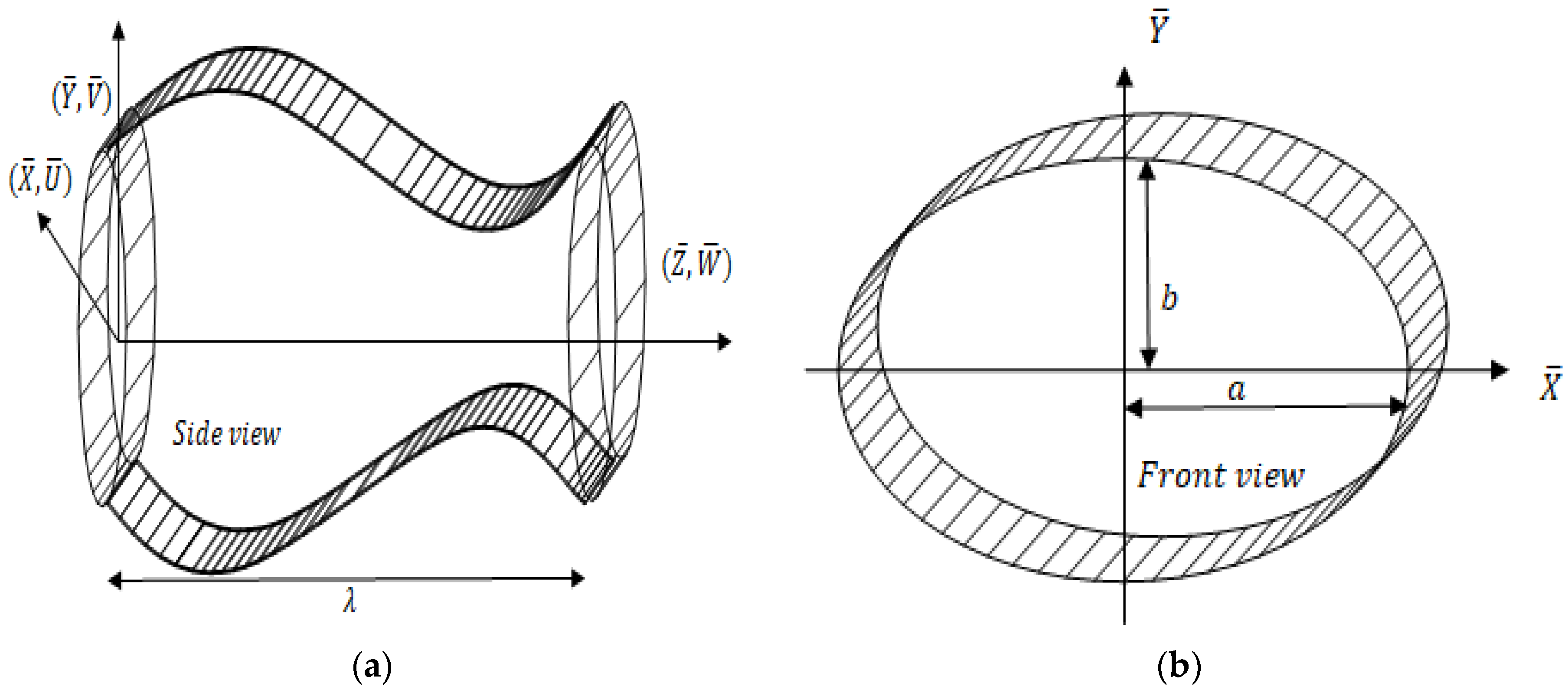
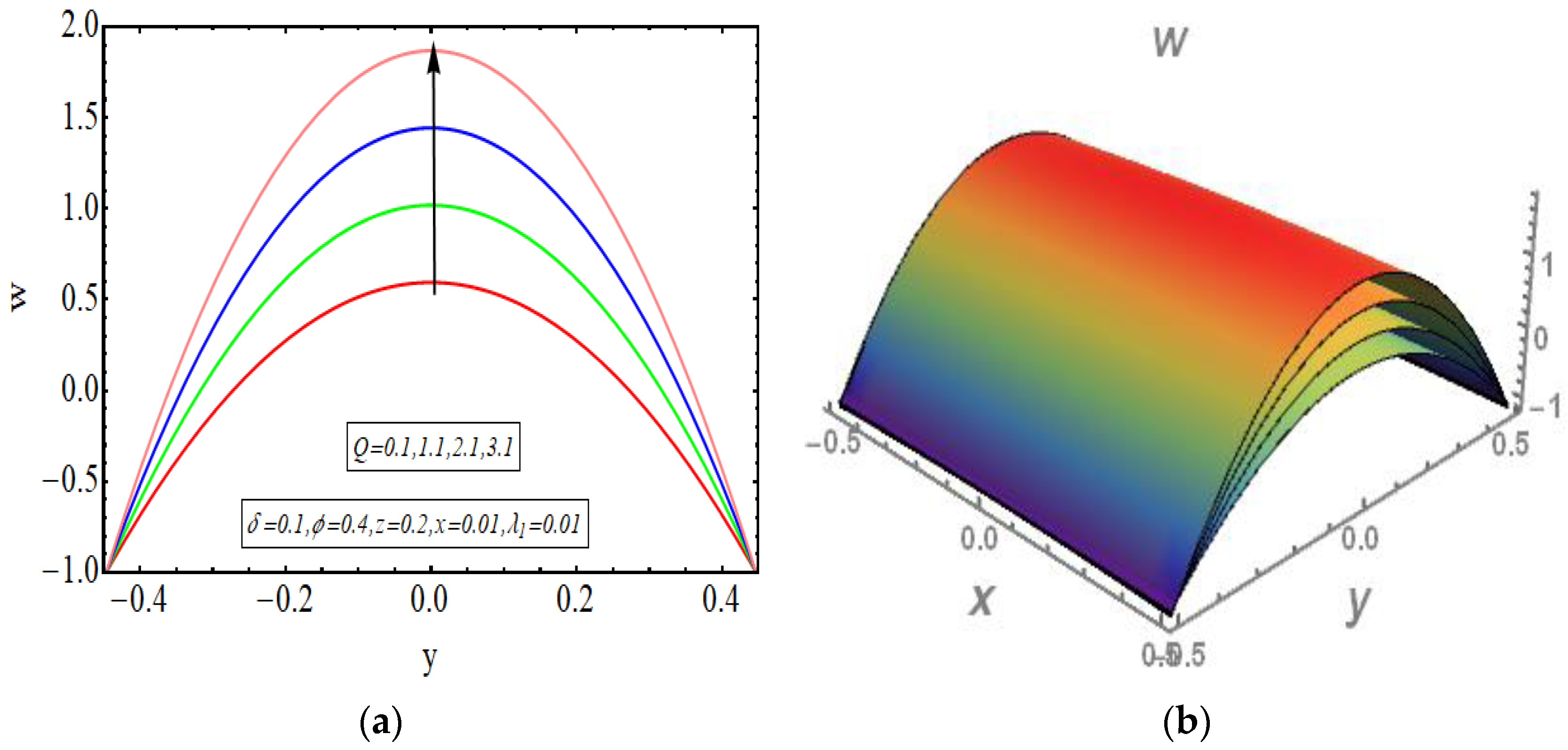
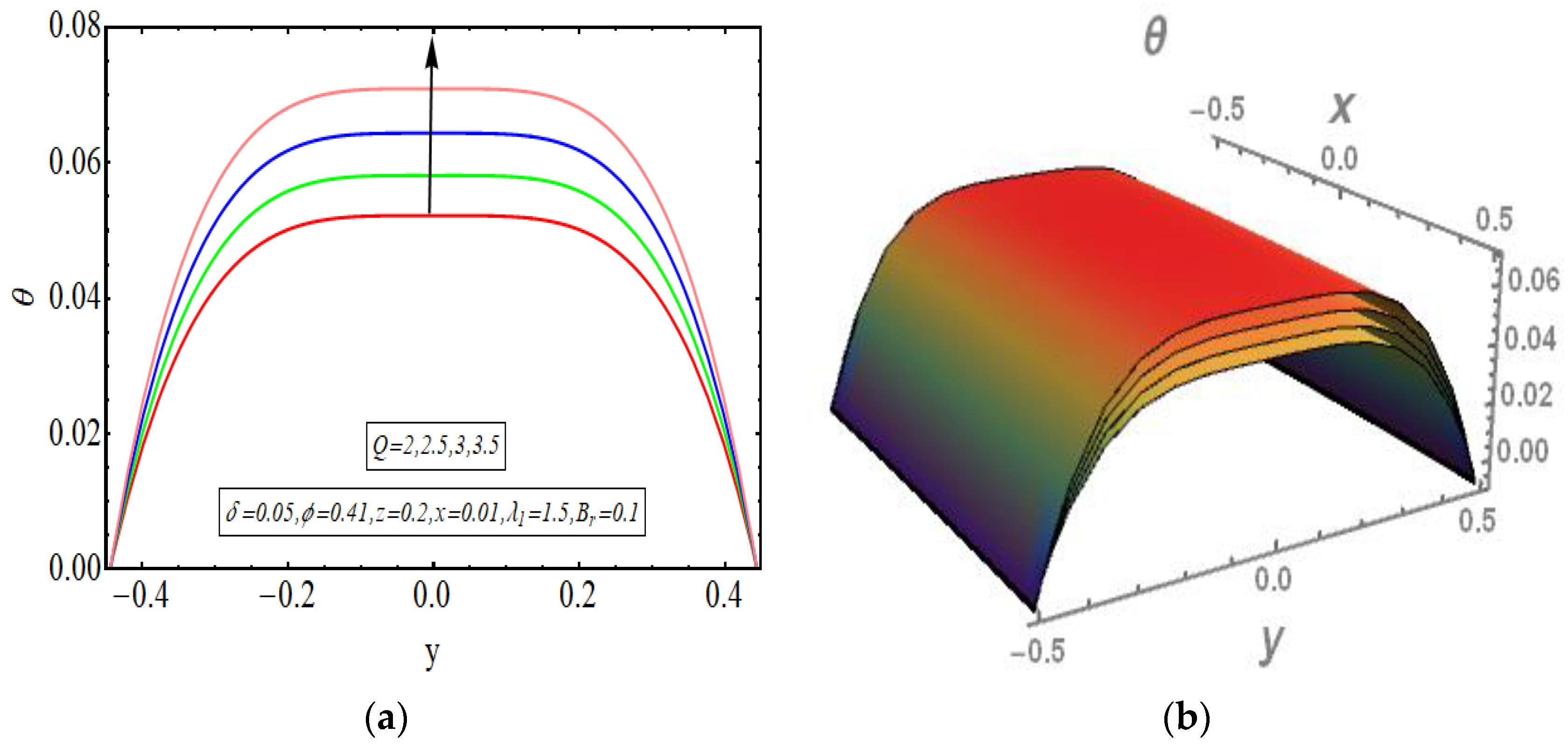
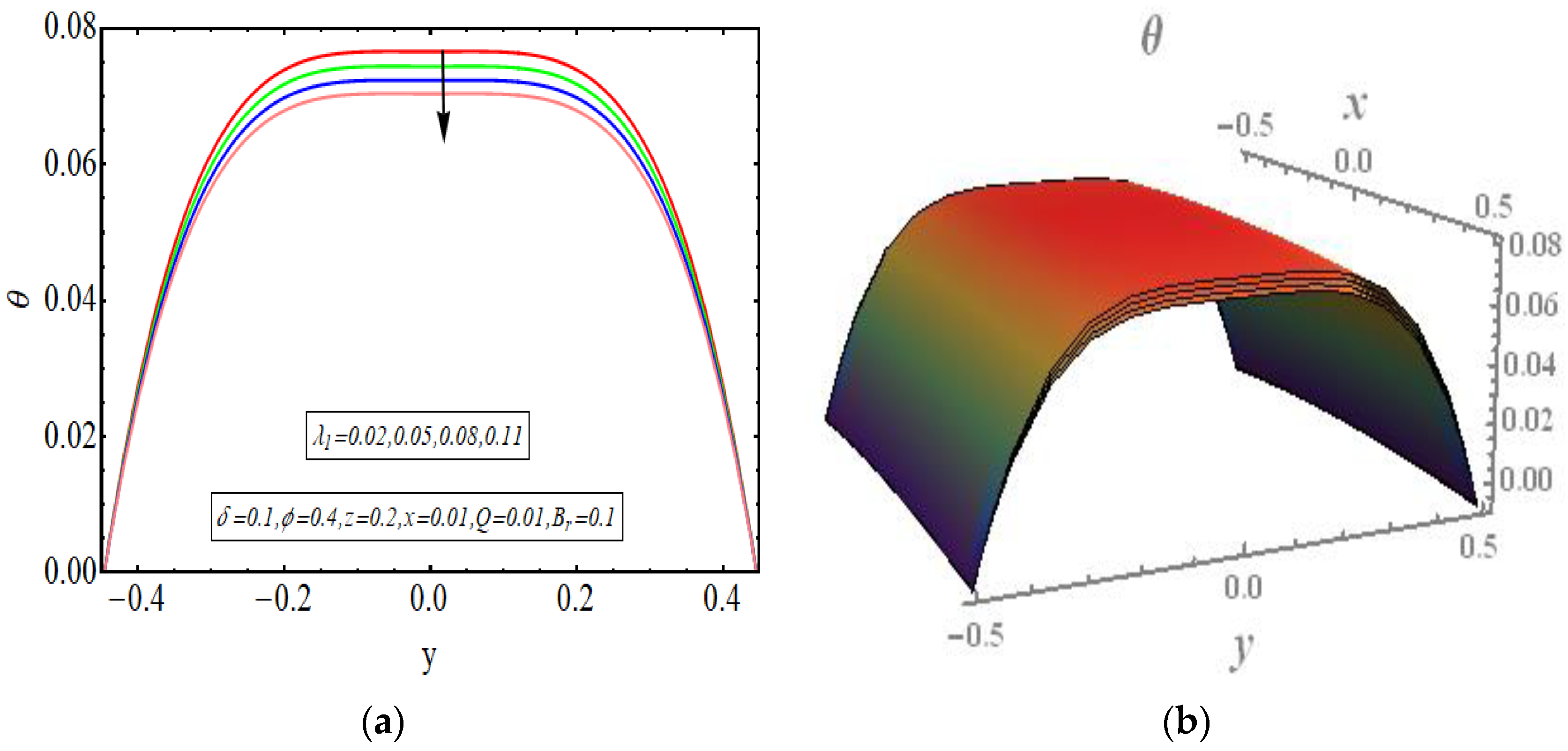
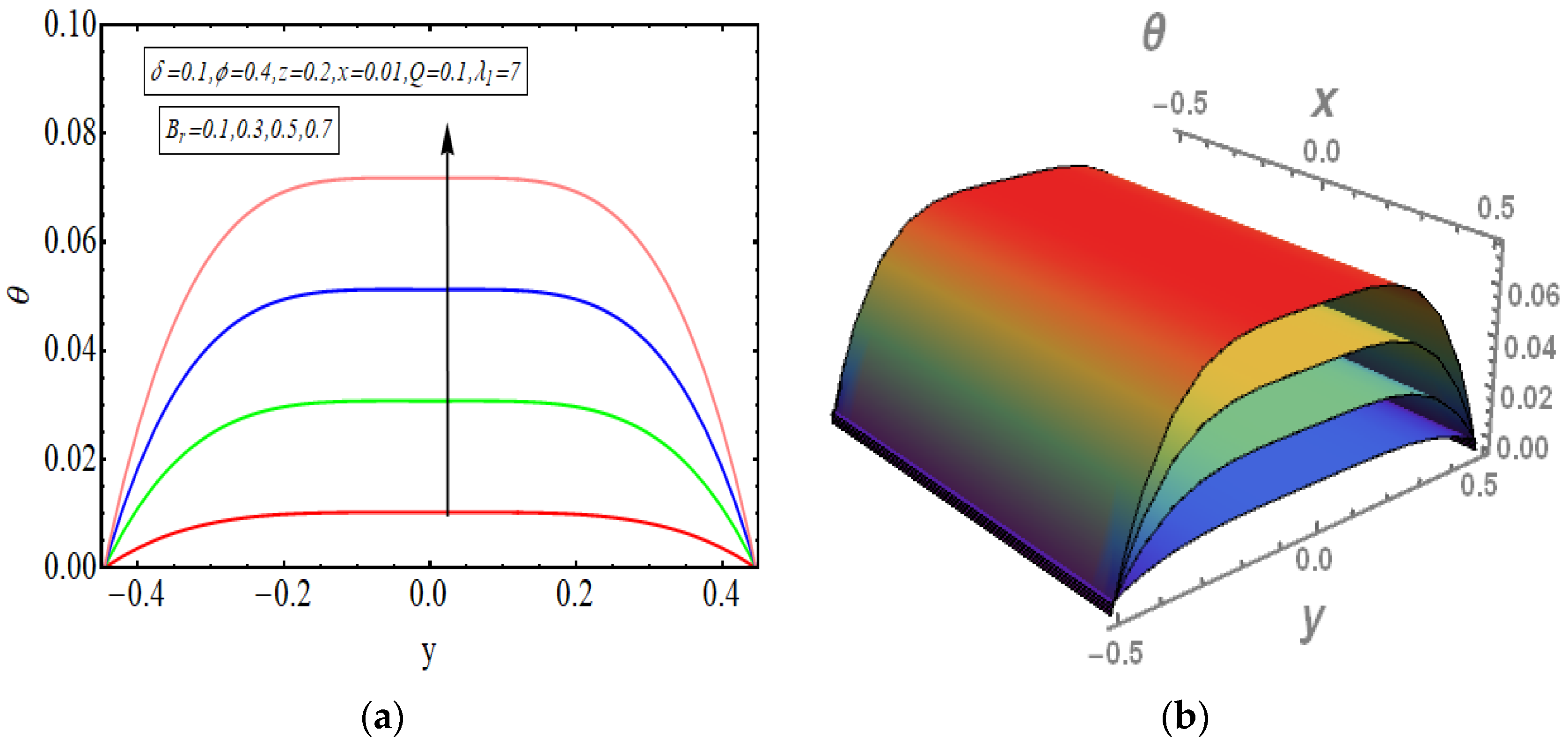
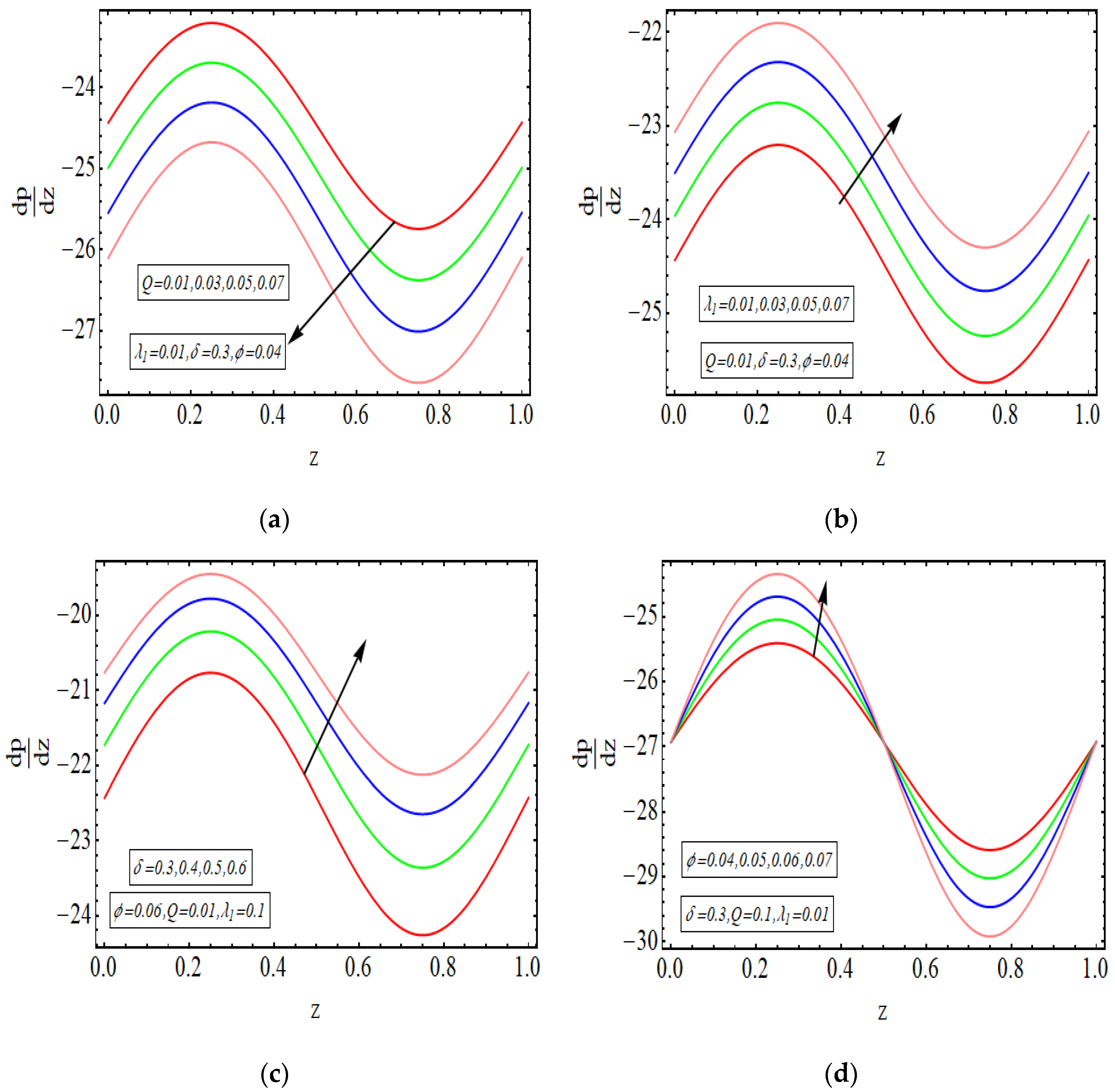
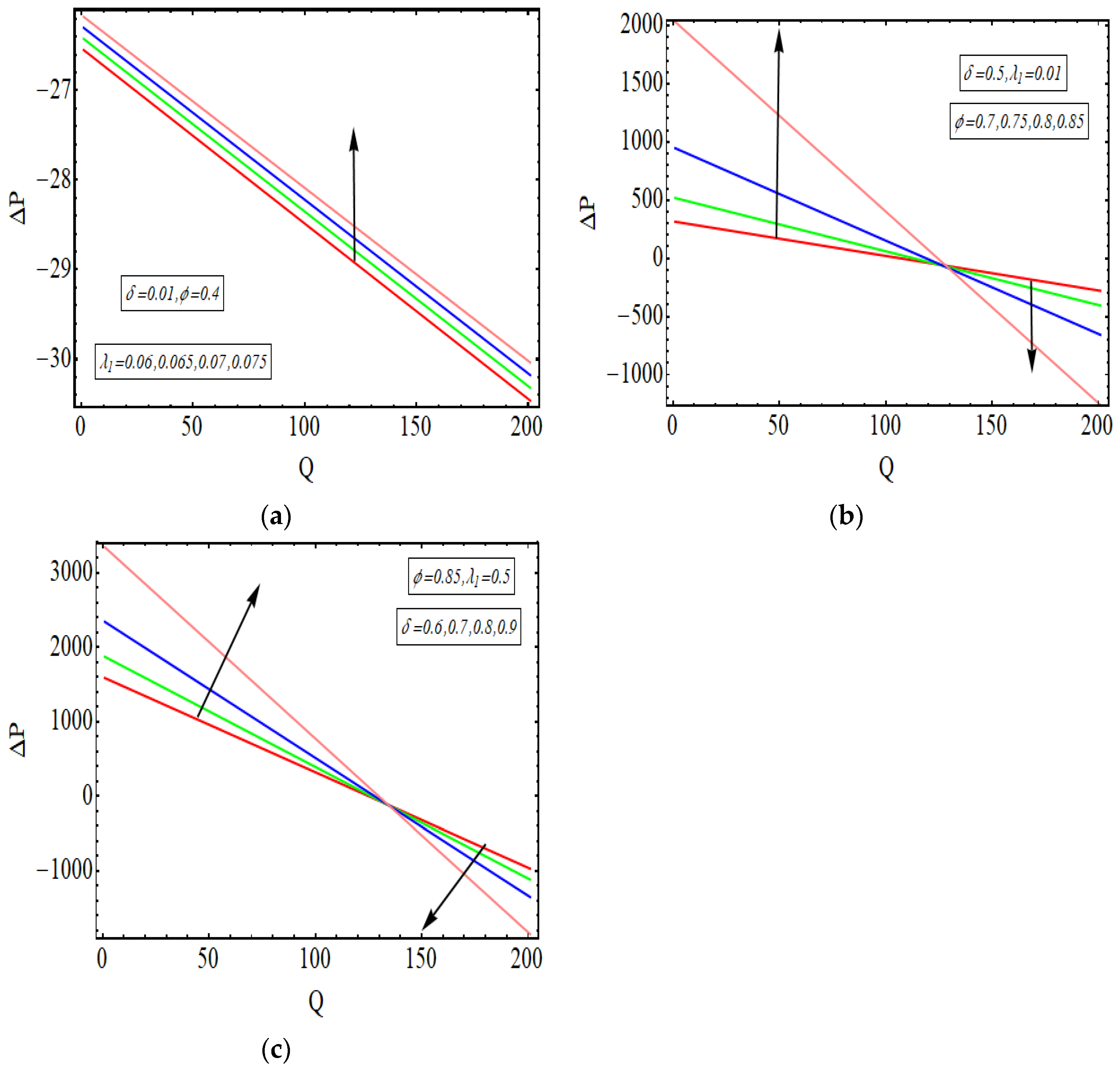
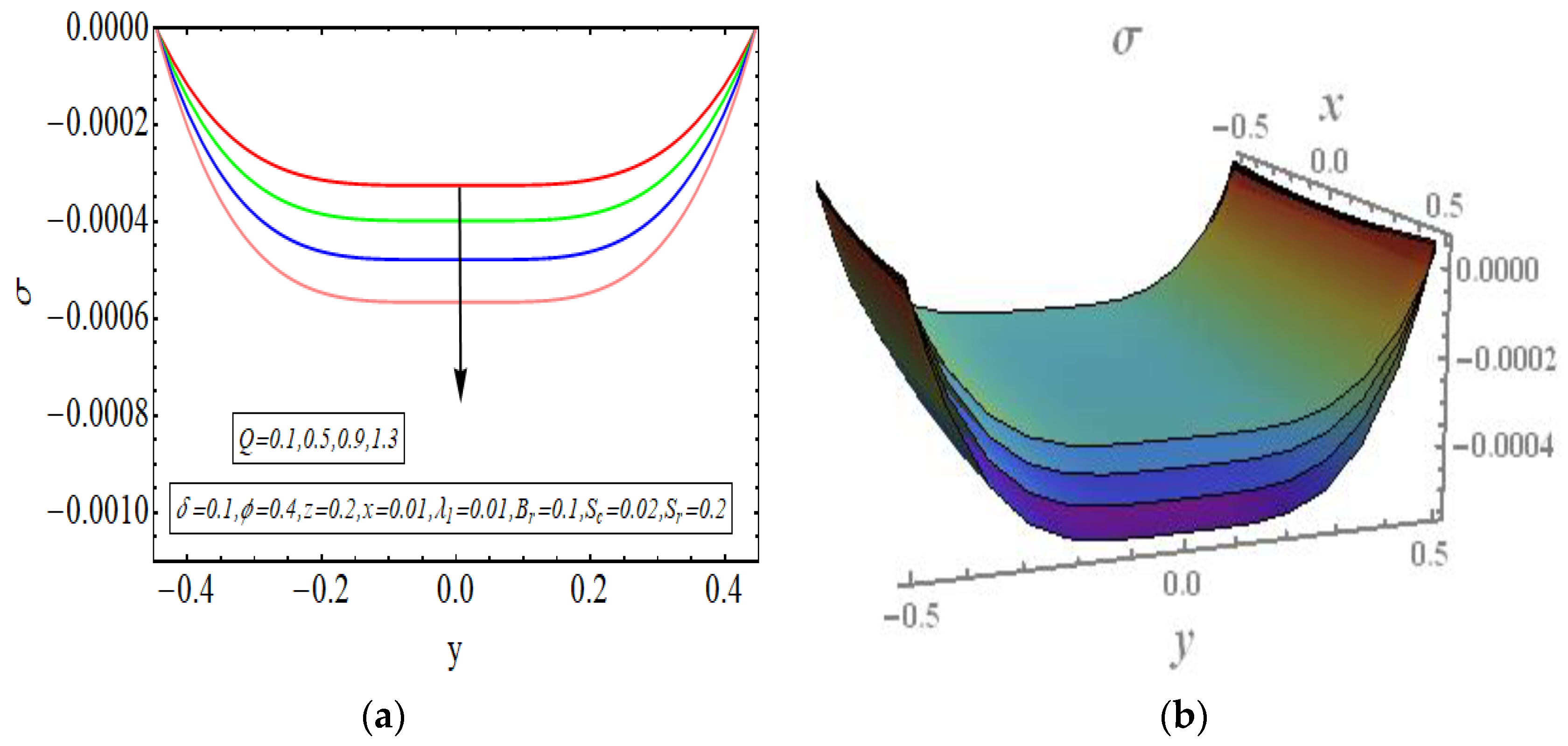
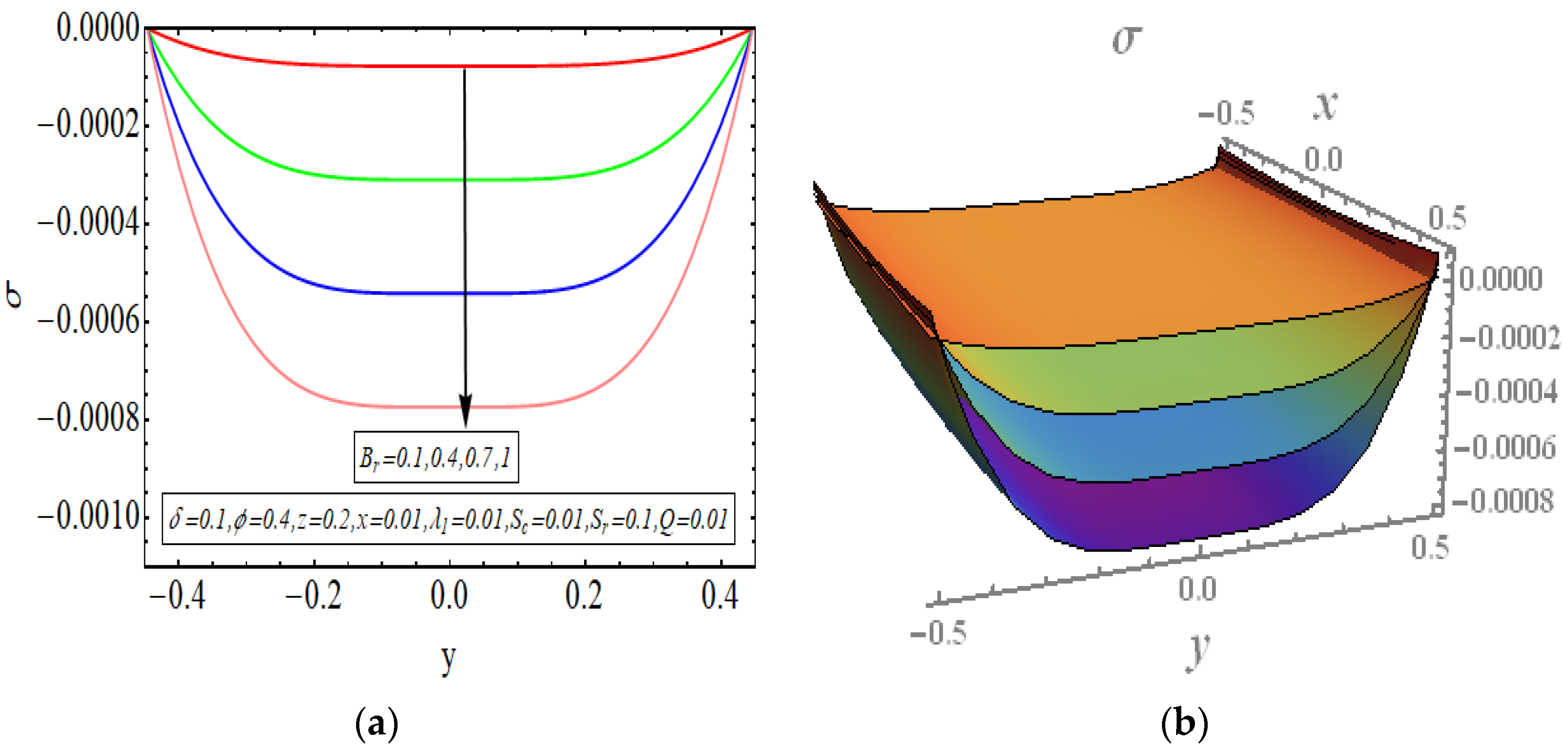

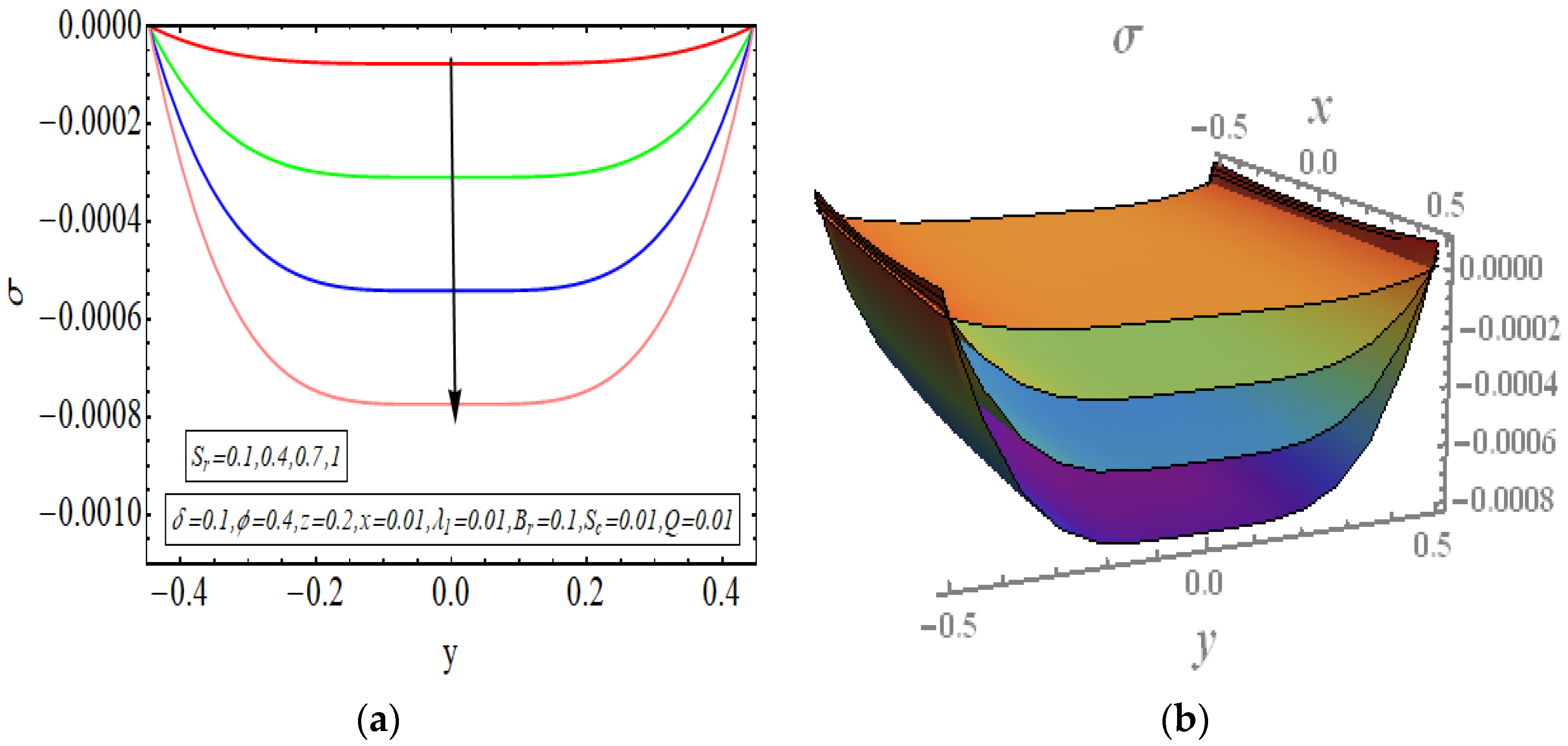
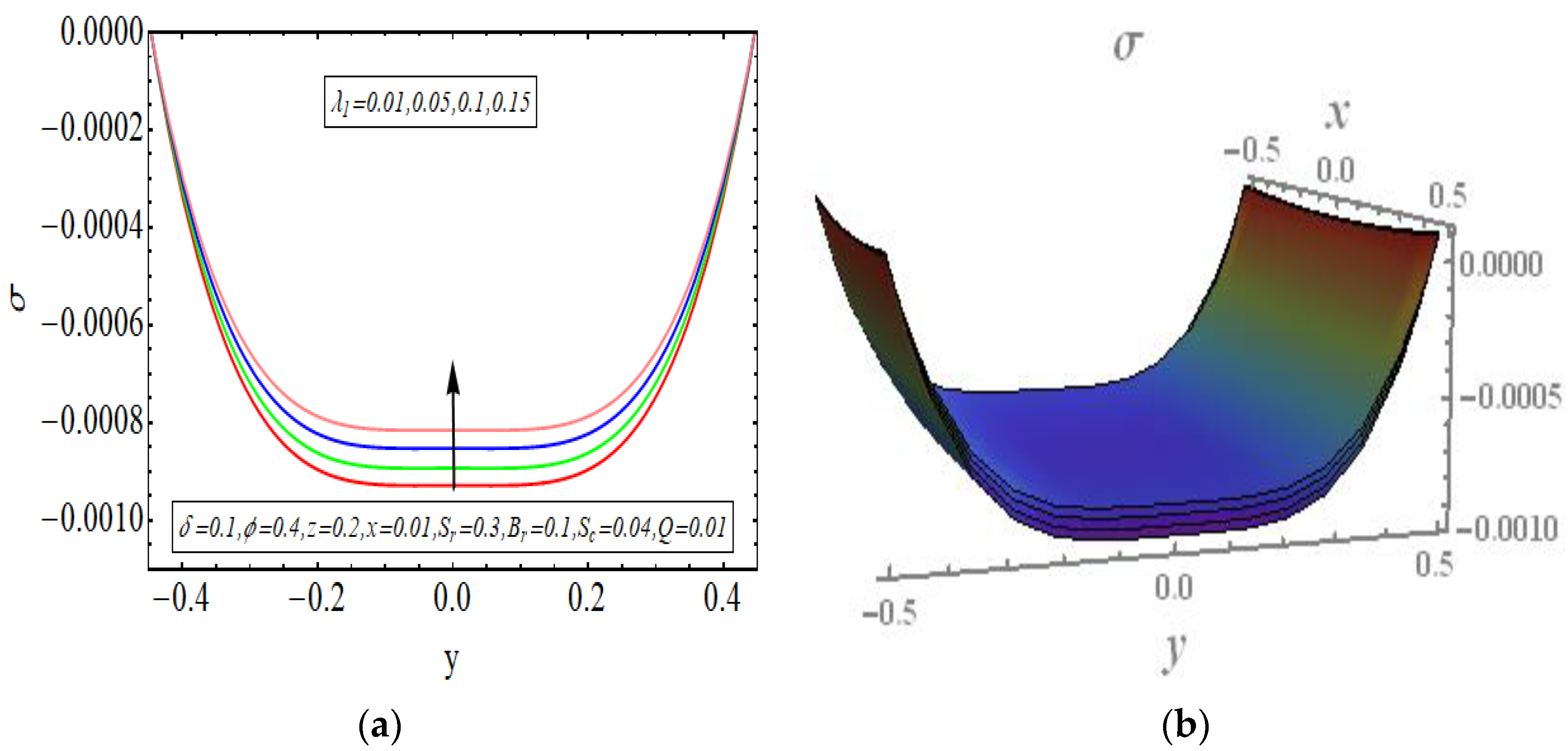

Publisher’s Note: MDPI stays neutral with regard to jurisdictional claims in published maps and institutional affiliations. |
© 2022 by the authors. Licensee MDPI, Basel, Switzerland. This article is an open access article distributed under the terms and conditions of the Creative Commons Attribution (CC BY) license (https://creativecommons.org/licenses/by/4.0/).
Share and Cite
Nadeem, S.; Waqar, H.; Akhtar, S.; Zidan, A.M.; Almutairi, S.; Ghazwani, H.A.S.; Kbiri Alaoui, M.; Tarek El-Waked, M. Mathematical Assessment of Convection and Diffusion Analysis for A Non-Circular Duct Flow with Viscous Dissipation: Application of Physiology. Symmetry 2022, 14, 1536. https://doi.org/10.3390/sym14081536
Nadeem S, Waqar H, Akhtar S, Zidan AM, Almutairi S, Ghazwani HAS, Kbiri Alaoui M, Tarek El-Waked M. Mathematical Assessment of Convection and Diffusion Analysis for A Non-Circular Duct Flow with Viscous Dissipation: Application of Physiology. Symmetry. 2022; 14(8):1536. https://doi.org/10.3390/sym14081536
Chicago/Turabian StyleNadeem, Sohail, Hiba Waqar, Salman Akhtar, Ahmed M. Zidan, Shahah Almutairi, Hassan Ali S. Ghazwani, Mohammed Kbiri Alaoui, and Mohamed Tarek El-Waked. 2022. "Mathematical Assessment of Convection and Diffusion Analysis for A Non-Circular Duct Flow with Viscous Dissipation: Application of Physiology" Symmetry 14, no. 8: 1536. https://doi.org/10.3390/sym14081536
APA StyleNadeem, S., Waqar, H., Akhtar, S., Zidan, A. M., Almutairi, S., Ghazwani, H. A. S., Kbiri Alaoui, M., & Tarek El-Waked, M. (2022). Mathematical Assessment of Convection and Diffusion Analysis for A Non-Circular Duct Flow with Viscous Dissipation: Application of Physiology. Symmetry, 14(8), 1536. https://doi.org/10.3390/sym14081536







